Cyligramma simplex is a moth of the family Noctuidae. This moth species is commonly found in Nigeria.

Cyligramma joa is a moth of the family Noctuidae. This moth species is commonly found in Madagascar.
Cyligramma amblyops is a moth of the family Noctuidae. This species of moth is commonly found in the Gold Coast region of Western Africa, now part of Ghana.
Cyligramma conradsi is a moth of the family Noctuidae. This moth species is commonly found in Tanzania.
Ophisma tropicalis is a moth of the family Noctuidae first described by Achille Guenée in 1852. It is found in tropical and subtropical America, from the south of the United States to Uruguay, including Brazil, Guadeloupe, Martinique, Saint Kitts, Montserrat, Saint Vincent, Grenada, the Greater Antilles, Cuba, the Dominican Republic, Jamaica and Colombia.
Ophisma pallescens is a moth of the family Noctuidae first described by Francis Walker in 1864. It is found in Thailand, Peninsular Malaysia, Sumatra, Borneo, Sulawesi, Seram and New Guinea.

Ophisma teterrima is a moth of the family Noctuidae first described by George Hampson in 1913. It is found in Africa, including Nigeria.

Bastilla absentimacula is a moth of the family Noctuidae. It is found from the Indian subregion to Sri Lanka, Andaman Islands, Taiwan, Java and New Guinea.

Bastilla acuta is a moth of the family Noctuidae. It is found in the Himalaya, Taiwan, Peninsular Malaysia, Sumatra and Borneo.

Bastilla joviana is a moth of the family Noctuidae first described by Stoll in 1782. It is found from the Oriental region to the Moluccas and in New Guinea and Australia. It is also present in South Africa.

Bastilla vitiensis is a moth of the family Noctuidae first described by Arthur Gardiner Butler in 1886. It is found from the Moluccas to Palau, Fiji, Samoa, Tonga and New Caledonia, Sulawesi, the Philippines, Borneo and Java.

Bastilla maturescens is a moth of the family Noctuidae first described by Francis Walker in 1858. It is found in the Indian subregion, Indochina, Thailand, Sumatra, Java and Borneo.

Bastilla maturata is a moth of the family Noctuidae first described by Francis Walker in 1858. It is found in the north-eastern parts of the Himalayas, southern China, Japan, Thailand, Peninsular Malaysia, Sumatra and Borneo.

Bastilla fulvotaenia is a moth of the family Noctuidae. It is found from the Indian subregion and Sri Lanka, Taiwan to Lombok, Seram and Buru. Adult is a fruit-piercer.

Bastilla solomonensis is a moth of the family Noctuidae first described by George Hampson in 1913. It is found on the Solomon Islands, the Bismarck Islands, New Caledonia, Vanuatu, New Guinea, Australia, Kei Island, the Moluccas, Java, Mindanao and the Philippines.
Bastilla duplicata is a moth of the family Noctuidae first described by Robinson in 1975. It is endemic to Fiji.
Bastilla copidiphora is a moth of the family Noctuidae. It is found in New Guinea and Australia.

Grammodes congenita is a moth of the family Noctuidae. It is found in Africa, including South Africa, Swaziland and Madagascar.
The Many-Lined Cordgrass Moth is a species of moth of the family Noctuidae. It is found in marshes along the Atlantic Coast of North America, with scattered inland wetlands records from Nova Scotia and New Brunswick south to Florida.
Hypocoena stigmatica is a species of moth of the family Noctuidae. It is found on the Faroe Islands and Iceland, as well as parts of Russia and Alaska.







